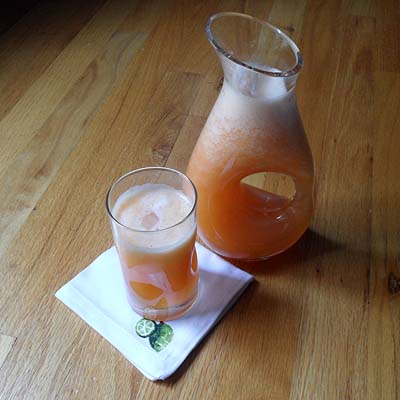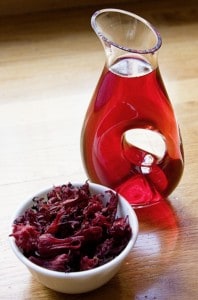Aguas frescas are a staple in most Mexican and Mexican-American homes, mine included. The best aguas frescas are made with ingredients that are in season because they’re easiest to get, typically cost less because they are more abundant, and have the best flavor because they’re at their peak growing season. Honeydew melon—also known as melón verde—is in season typically from May to October, with the peak from May to August, but we’ve been seeing a lot of this melon in the grocery stores in Southern California since mid-March. This honeydew and cucumber agua fresca recipe is light and refreshing for warm spring and summer days. You can also opt to serve it straight as a juice with breakfast—just run through a juicer or powerful blender and leave out the water and optional sugar.
aguas frescas
Mango agua fresca
Agua de mango is a popular agua fresca flavor in Mexico. Mangoes are high in fiber, packed with Vitamin A, C and E, have more than 25 kinds of carotenoids which help boost immunity, and can help lower cholesterol.
Ataulfo mangoes are best for this recipe because they are the sweetest variety and also least fibrous texture, which means you’ll discard less pulp.
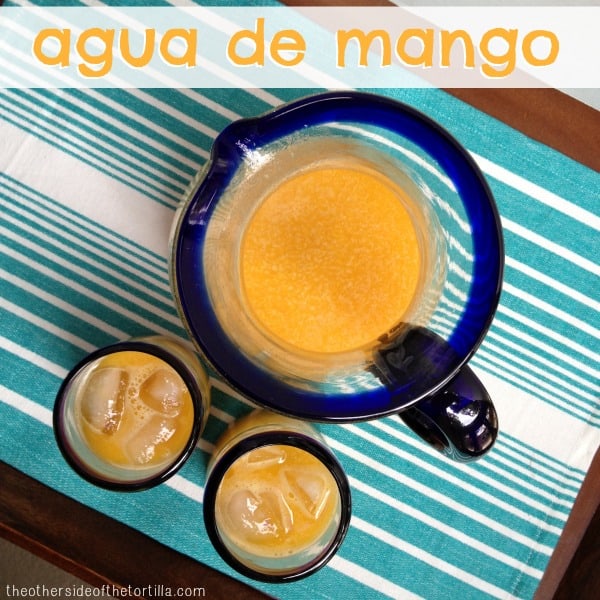
Close substitutes or other names for this kind of mango can include Manila mangoes, honey mangoes or champagne mangoes.
Ataulfo mangoes are in peak season between March and June, but can often be found in stores all the way through December depending on the part of the country where you live.
Leave the mangoes out on the counter at room temperature for a few days if they’re firm at the time you buy them. You’ll know they’re ripe and ready to use when the skin gives a little when you press it and/or the skin starts to wrinkle slightly. If the skin is already wrinkled when you buy them, they’re ready to use immediately.
This variety of mango is less fibrous than the Tommy Atkins (green with red blush) variety, and therefore is more ideal for making aguas frescas.
If you like this recipe, you may also like my agua de fresa y mango recipe (strawberry and mango).
Print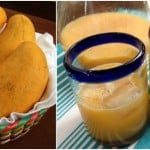
Mango agua fresca
- Prep Time: 20
- Total Time: 20 minutes
- Yield: 5 cups 1x
- Category: Drinks
- Cuisine: Mexican
Description
Ataulfo mangoes are best for this agua fresca recipe because they are the sweetest variety and also least fibrous texture, which means you’ll discard less pulp.
Ingredients
- 2 Ataulfo or Manila mangoes
- 3 1/2 cups cold water
- 3 tablespoons natural cane sugar (such as Zulka azúcar morena)
Instructions
- Peel the mangoes and remove all the flesh from the pit. Put the flesh directly into a blender or food processor. Squeeze the juice out of any remaining flesh on the pit that is too difficult or rough to cut away from the pit.
- Add 3 tablespoons of cane sugar and 3 1/2 cups of cold water to the blender or food processor and puree until completely smooth.
- Place a fine-mesh strainer or sieve over a pitcher and pour the contents of the blender through the sieve. You should only end up discarding about 2 tablespoons or so of the fibrous pulp left behind from the mango flesh.
- Serve over ice if serving immediately, or refrigerate. Will last about 4-5 days in the refrigerator.
Notes
Serve over ice. If you don’t consume it all, you can refrigerate the rest of the pitcher for up to four days. Remember to stir the agua fresca well because the mango puree will separate slightly when at rest.
Nutrition
- Serving Size: 1 cup
Keywords: mango
Try more of my aguas frescas recipes:
Agua de jamaica | Agua de mandarina | Agua de melon | Horchata | Agua de tuna roja (red prickly pear) | Agua de piña | Limonada
Try more of my mango recipes:
Mangonada paletas | Mango and peach paletas | Paletas de mango con chile | Guacamole with mango and pomegranate seeds
Agua fresca de mandarina
Mandarin oranges make a very refreshing agua fresca.
This is an incredibly simple recipe, but one I’ve been asked for time and again by friends. It’s perfect for serving with any meal, and any gathering—large or small.

I love mandarin oranges both because of the refreshing, sweet juice they produce and their portability as a vitamin-packed snack.
When I first met my cuñada, she used to take me out for aguas frescas and we almost always ended up with agua de mandarina, one of her favorites—and consequently, now, one of my favorites too.
Aside from agua fresca de mandarina, this citrus fruit is also great for making mandarin orange margaritas!
Agua de melón
Today on the Kenmore Genius Blog, I’m sharing a quick and simple recipe to make agua de melón in your blender. I especially love to drink this with breakfast.
The basic ingredients: Cantaloupe, a little sugar, water and a squeeze of fresh lime juice. If your melon is super ripe, you can also reduce the sugar by half or leave it out completely for a healthier, no-sugar-added version—it’s up to you. Hop on over to the Genius Blog for more on this recipe. This recipe calls for cantaloupe, but you can also use honeydew melon (melón verde).
Ingredients
- 1/2 of a ripe cantaloupe
- 1/4 cup of sugar dissolved in a half cup of warm water
- 1 cup of cold water
- Optional: juice of half a lime
Instructions
- Dissolve the sugar in a half cup of warm water to create a simple syrup. Set aside and allow to come to room temperature.
- Cut the cantaloupe into cubes and put it into the blender with 1 cup of water until it’s completely liquified and smooth.
- Place a fine sieve over a pitcher and pour the contents of the blender through it to strain. Use a spoon to press any remaining juice through the sieve.
- Add the simple syrup to the pitcher and stir well. If you opt to use the lime juice, add that after the simple syrup.
- Serve chilled or over ice. Yields 3 to 3-1/2 cups of juice, depending on the ripeness of your cantaloupe. Refrigerate any juice you’re not going to drink immediately and consume within two days.
https://theothersideofthetortilla.com/2011/09/agua-fresca-agua-de-melon/
If you want to read more about aguas frescas, check out some of my previous recipes here on The Other Side of The Tortilla:
Did you like this recipe? Please share it with your familia and amigos! ¡Gracias!
How to make horchata
I can’t tell you how many times I’ve been asked for an horchata recipe since I began blogging. But each time I start explaining how to make it from scratch, I can see people start to lose interest around the time I mention that making horchata from scratch involves soaking rice and cinnamon sticks overnight and then grinding it and straining it. When I make it from scratch I sometimes also blanche almonds and soak them with the rice for an added depth of flavor. But the average person asking for a recipe always seems to get a frown on their face when they realize making it from scratch takes a little extra time and effort.
[youtube]http://www.youtube.com/watch?v=jcm9_7LVHv0[/youtube]
RELATED RECIPE: Oaxaca-style paletas de horchata
It was because of this dilemma of nobody wanting to take the time to soak and grind the rice that I began experimenting in the test kitchen to try to make an acceptable quick recipe substitute for those times when we just need a quick fix of a tall, cool glass of horchata. This is the simplest recipe I came up with that passed the taste test with family and friends. It beats any powdered or pre-made liquid mix I’ve tried from a variety of grocery stores. The store-bought mixes always taste either too sweet or too fake to me. I hope you enjoy this version if you’re looking for a quick but yummy horchata recipe!
…
Agua de tuna roja
[vimeo]http://www.vimeo.com/15416696[/vimeo]
I still remember the first time I saw tunas growing wild – José and I were visiting Mexico City one warm week at the end of the summer several years ago. One afternoon we were bored, so my suegra suggested that José take me on an official tour of Ciudad Universitaria. Also referred to as CU, it is home to the main campus of Universidad Nacional Autónoma de México (la UNAM or in English, the National Autonomous University of Mexico), the largest university in Latin America and a UNESCO World Heritage site since 2007.
This year on September 22, UNAM celebrated 100 years since its founding as the National University of Mexico as it was conceptualized by Secretary and Minister of Public Instruction and Fine Arts, Justo Sierra, and inaugurated in 1910 by President Porfirio Díaz. The university is also the successor to the Royal and Pontifical University of Mexico, founded by Spanish Royal Decree in 1551 – technically making UNAM one of the oldest universities in the Americas.
On the campus grounds, besides the historic buildings designed by some of Mexico’s most well-known architects, murals and sculptures by famous Mexican artists, an Olympic stadium that has hosted a Summer Olympic Games (1968) and a World Cup (1986), and an impressive number of students, faculty and staff, there exists a serene, green space that is as close to the original land’s flora and fauna as it might have grown freely during the height of the Aztec empire….
How to make agua de piña two ways
Agua de piña is a very popular agua fresca served all over Mexico, and made from just a few ingredients.
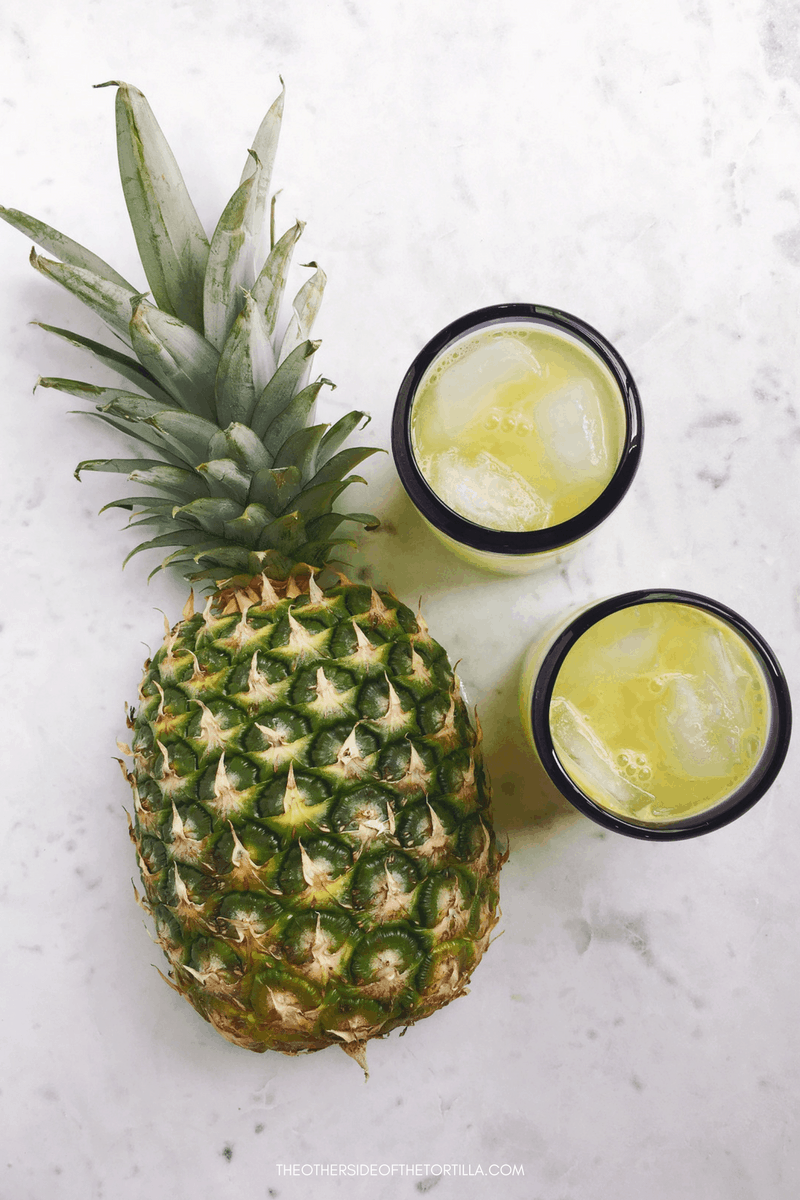
…
Agua de jamaica
Agua de jamaica is a staple agua fresca flavor made with dried hibiscus flowers.
Jamaica (pronounced “HAH-MY-CAH” in English; not like the country Jamaica) is a simple but unique drink, and has only two ingredients other than water. Aguas frescas—literally, “fresh water” fruit drinks—are very common all over Mexico. They come in many flavors: horchata (made with a rice-base), sandía (watermelon), agua de piña (pineapple), limón (lime), tamarindo (tamarind), naranja (orange), agua de mango and so on.
There are a lot of places in Mexico where you can buy aguas frescas out on the street, in the market, or as pre-made powder mixes. Most people make them at home from scratch because it’s so easy. Every time we visit family in Mexico, nearly every meal made at home is accompanied by an agua fresca.
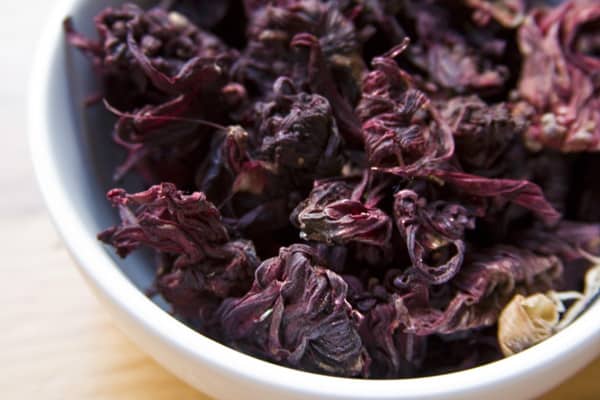
Jamaica is made like tea, infusing the flavor and purple-red color of hibiscus calyces.
Like tea, jamaica is also a natural diuretic so don’t go drinking the whole pitcher in one day. (Yes, I once did that. You might also want to avoid drinking too much jamaica before bedtime.) The only real variation among recipes are the ratios used of sugar to water, and whether or not you dilute the juice (and if so, how much) when serving.
Some households serve their agua de jamaica a bit more tart like cranberry juice; we like ours a little on the sweeter side. I dilute it by adding half a glass of water to half a glass of juice.
I prefer a brand of granulated cane sugar called Zulka, which is Mexican, non-GMO, vegan-friendly and can be substituted 1:1 with processed white sugar. You can generally find this brand in all Mexican markets, many Latin American specialty grocers and even some mainstream retailers such as Target and Walmart.
Agua de jamaica
Prep
Cook
Inactive
Total
Yield 6 cups concentrated juice (should be diluted before consuming)
Agua de jamaica is a classic Mexican agua fresca recipe made with dried hibiscus flowers.
Ingredients
- 2 cups (about 2 ounces in weight) dried flor de jamaica (hibiscus flower calyces)
- 3/4 to 1 cup Zulka morena granulated cane sugar
- 8 cups water
Instructions
- Bring 8 cups of water to a boil in a non-corrosive pot and add the flowers and the sugar. Stir to wet all the flowers and dissolve the sugar, and allow to boil for 3-5 minutes undisturbed.
- Remove from heat, stir, and allow to steep and cool to room temperature for about 1 1/2 to 2 hours.
- Using a sieve over a pitcher, pour the liquid (with the flowers still in it) through the sieve to filter the flowers out. The flowers will have plumped up during rehydration. Press them against the sieve with your fingers or a spoon to extract any extra juice left inside.
- Refrigerate. When serving, cut with 50 percent water to dilute.
Notes
Total time includes 2 hours of cooling time for the concentrated juice to come to room temperature before serving or bottling and refrigerating.
*This recipe is vegan-friendly when using Zulka morena sugar.
Cuisine Mexican
MORE AGUAS FRESCAS RECIPES:
- Honeydew melon and cucumber (melón verde y pepino) agua fresca
- Mandarin orange (agua de mandarina) agua fresca
- Cantaloupe (agua de melón) agua fresca
- Red prickly pear (agua de tuna roja) agua fresca
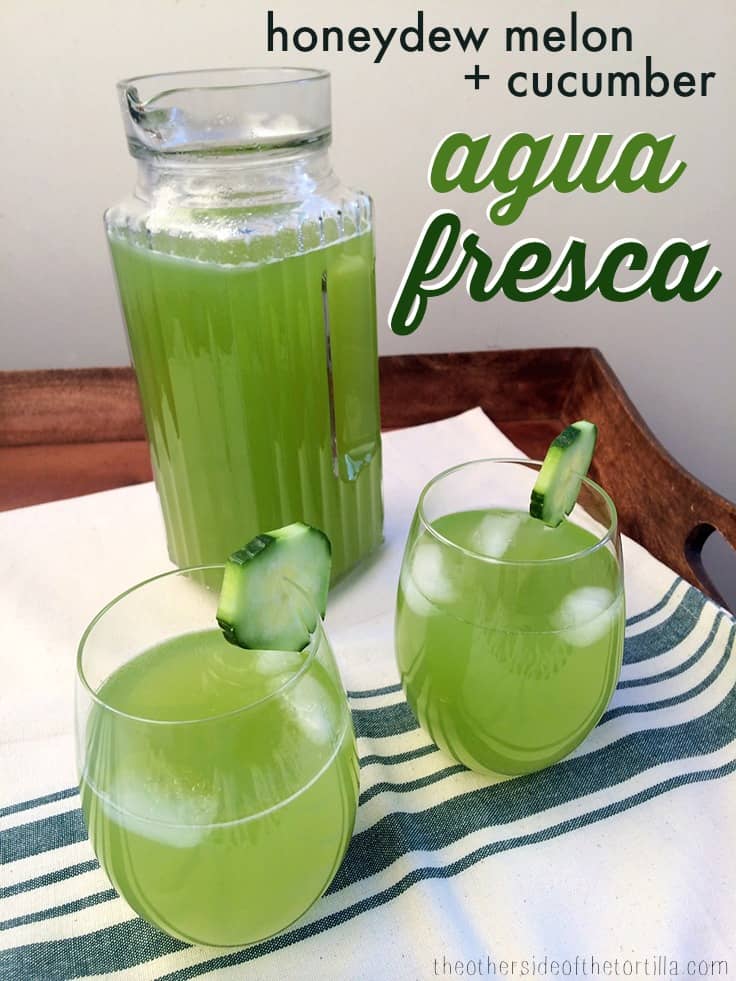 …
…
